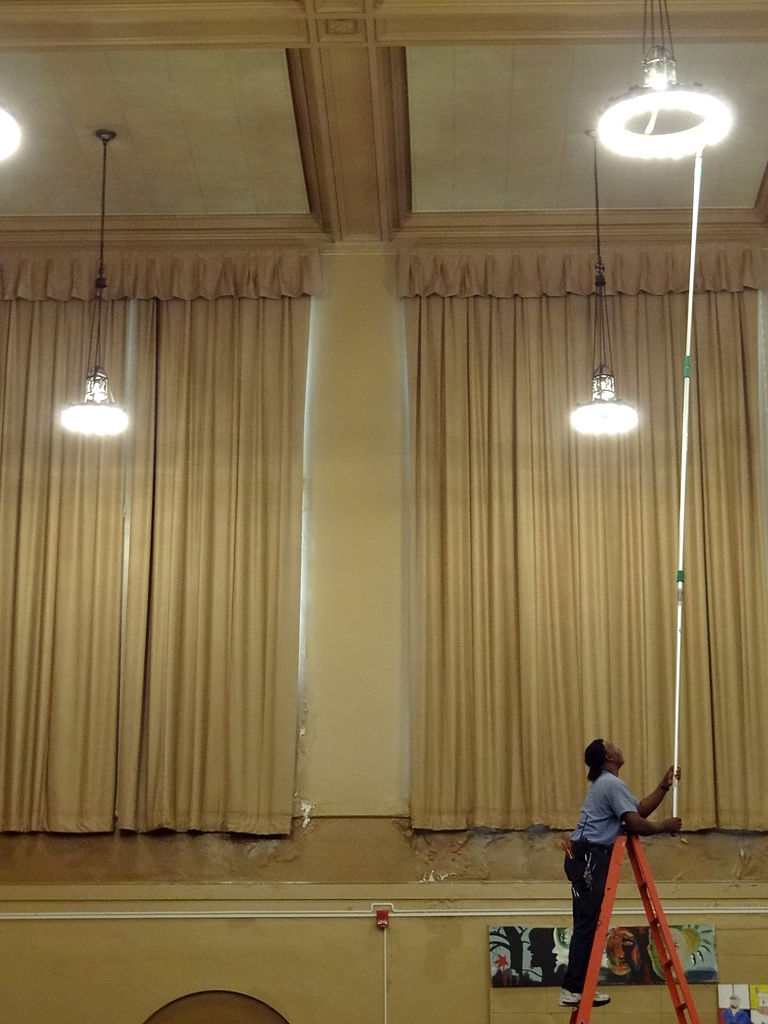Working with lighting maintenance contractors
Contents |
[edit] Introduction
Lighting maintenance contractors can be appointed to keep light fittings clean and change lamps regularly. Proper lighting maintenance also means that the correct lamps will continue to be used throughout the building’s lifetime.
In new buildings, proper maintenance can ensure that lighting satisfies the intention of the lighting designer. When properly executed, lighting maintenance measures in existing buildings can contribute to energy savings and more approriate light levels.
[edit] Relamping and cleaning
Lighting contractors should be required to provide planned maintenance. This establishes a framework for an effective maintenance programme, including regular relamping, cleaning and disposal.
By replacing lamps as their light output (but not their energy consumption) begins to decline, rather than waiting for them to fail, the lighting system should produce better average illuminance. This means that fewer lamps and fixtures are needed to maintain proper working conditions.
One approach to relamping is group relamping. This means changing all of the lamps at the same time on a scheduled basis. This practice consolidates labour and resources that would otherwise be required each time an individual lamp needed to be replaced.
Group relamping may be more cost effective when labour expenses are high and lamp costs are low. Cleaning can also be included during a group relamping, as labour will already be allocated.
Lighting maintenance contractors should be prepared to handle the proper disposal of materials. This should include recycling if possible.
[edit] Coordination between maintenance contractors and lighting designers
The installation of long life light sources will be important for lighting maintenance contractors when lights are installed in hard to reach locations. Lighting should also have accessible features and minimal components that can be easily removed for servicing. Maintenance will be more efficient when the number of lamp types in a building is minimised.
To assist with the maintenance process, lighting designers should be asked to provide a written maintenance policy, including recommended maintenance procedures and equipment replacement schedules. The design should reflect the intended level of maintenance to produce the correct light levels.
Contractors may be able to maintain lighting systems adequately, but this cannot prevent systems from becoming inefficient when modifications to a space create lighting conditions that are no longer suitable for the activities being performed. Lighting designers should be informed of significant changes made to the allocation of space within the building, and systems should be adjusted accordingly - both to maximise employee productivity levels and minimise wasted energy caused by misdirected lighting.
[edit] Related articles on Designing Buildings
Featured articles and news
The UK’s largest air pollution campaign.
Future Homes Standard, now includes solar, but what else?
Will the new standard, due to in the Autumn, go far enough in terms of performance ?
BSRIA Briefing: Cleaner Air, Better tomorrow
A look back at issues relating to inside and outside air quality, discussed during the BSRIA briefing in 2023.
Restoring Abbotsford's hothouse
Bringing the writer Walter Scott's garden to life.
Reflections on the spending review with CIAT.
Retired firefighter cycles world to raise Grenfell funds
Leaving on 14 June 2025 Stephen will raise money for youth and schools through the Grenfell Foundation.
Key points for construction at a glance with industry reactions.
Functionality, visibility and sustainability
The simpler approach to specification.
Architects, architecture, buildings, and inspiration in film
The close ties between makers and the movies, with our long list of suggested viewing.
SELECT three-point plan for action issued to MSPs
Call for Scottish regulation, green skills and recognition of electrotechnical industry as part of a manifesto for Scottish Parliamentary elections.
UCEM becomes the University of the Built Environment
Major milestone in its 106-year history, follows recent merger with London School of Architecture (LSE).
Professional practical experience for Architects in training
The long process to transform the nature of education and professional practical experience in the Architecture profession following recent reports.
A people-first approach to retrofit
Moving away from the destructive paradigm of fabric-first.
International Electrician Day, 10 June 2025
Celebrating the role of electrical engineers from André-Marie Amperè, today and for the future.
New guide for clients launched at Houses of Parliament
'There has never been a more important time for clients to step up and ...ask the right questions'
The impact of recycled slate tiles
Innovation across the decades.
EPC changes for existing buildings
Changes and their context as the new RdSAP methodology comes into use from 15 June.
























